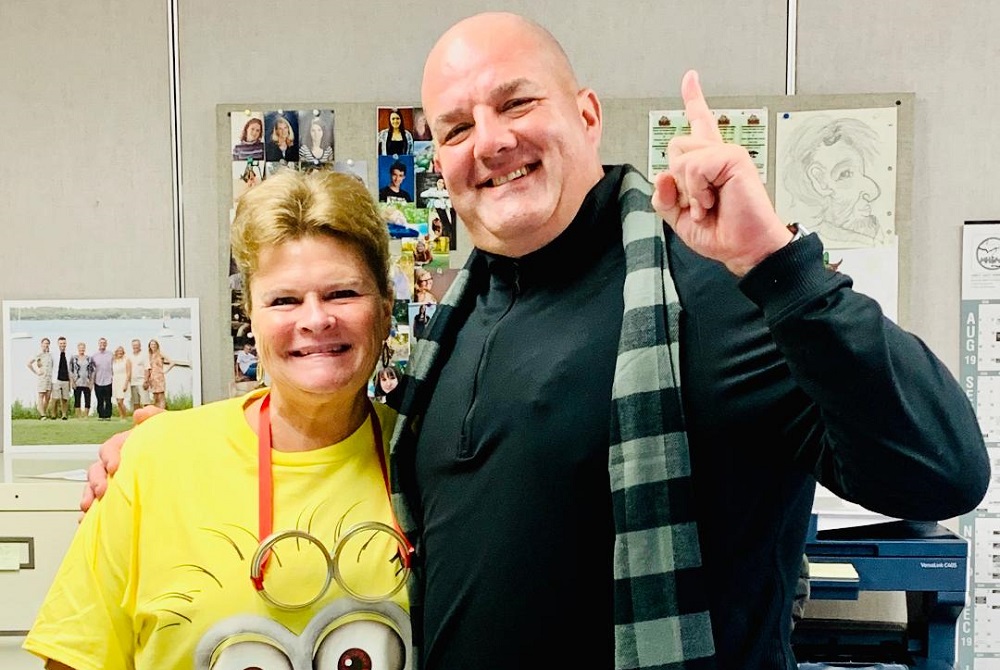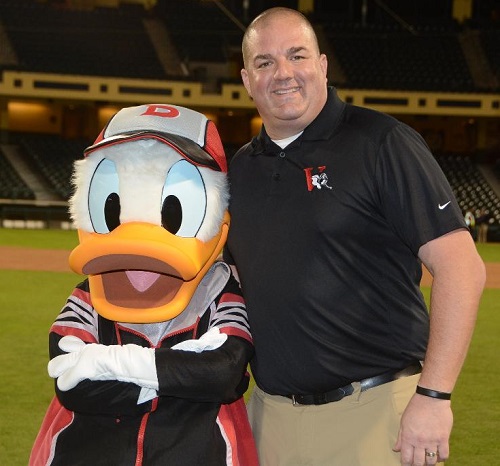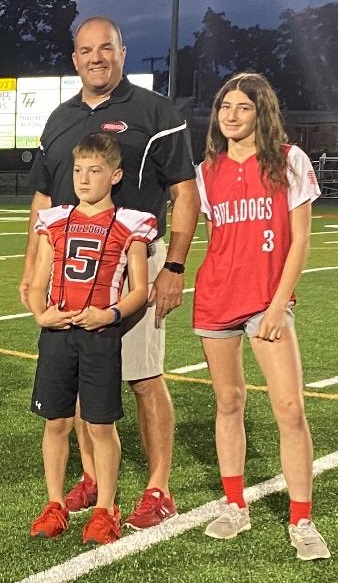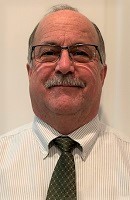
Vicksburg AD Roy Honored Nationally for Service to School Sports
By
Pam Shebest
Special for MHSAA.com
February 15, 2022
VICKSBURG — Accepting an award on a national stage is an impressive feat for any athletic director.
 But it was even more special for Vicksburg AD Mike Roy, who shared that stage with his mentor and good buddy.
But it was even more special for Vicksburg AD Mike Roy, who shared that stage with his mentor and good buddy.
While Roy was presented a Distinguished Service Award from the National Interscholastic Athletic Administrators Association in December, retired AD Mike Garvey was inducted into its Hall of Fame.
“This award from the NIAAA was exceptionally special to me because Mike got inducted the very same night into the NIAAA Hall of Fame,” Roy said.
“To be able to receive that award with someone who means so much to me and has guided me and been so influential in my career was the icing on the top, the cherry.”
Garvey said to be mentioned as Roy’s mentor “is an amazing compliment. When the Hall of Fame asked me to send some photos, I had to have him in one.”
The two men first connected 23 years ago when Garvey left Lawton High School for the AD’s job in Delton. Roy filled the Lawton position.
“Mike took me under his wing,” Roy said. “He introduced me to another great friend, Fred Smith.
“Just a couple guys who are awesome gentlemen who are recognized throughout the country.”
Garvey reflects that admiration.
“Mike Roy has been recognized in Michigan and it’s time the rest of the country knows how great he is.” Garvey said.
“It was wonderful to share the stage with him. He’s a high-energy person who attacks everything with vigor. He gets things done.”
Two years ago, Roy received the MHSAA’s Allen W. Bush for service, prompting a Roy-like comment.
“With my joking, sarcastic system, I said to myself, ‘I must be getting old because I’m starting to get these awards and being recognized for it,’” he said.
“But, really, upon hearing it, you just sit back and are really taken aback and humbled by it.”
Rooted in Paw Paw
Roy started his athletic career in Paw Paw with football, basketball, baseball and track in high school.
After turning down offers from Division III schools, Roy accepted a football scholarship to University of Nevada, Las Vegas, which was an eye-opener.
“I found out very quickly when I got to UNLV to play football that I was no longer the big fish in the pond,” he said. “I was a very small fish in a very big pond.
“Going to UNLV forced me to grow up. Sometimes when reality smacks you in the face, it kind of wakes you up.”
That experience helps him guide high school athletes today.
 “Looking back now, there are some things I wish I had done on the academic side of it,” he said. “I wasn’t a great student; I wasn’t a terrible student. I wish I had done better.
“Looking back now, there are some things I wish I had done on the academic side of it,” he said. “I wasn’t a great student; I wasn’t a terrible student. I wish I had done better.
“My career goal at that time, wishful as it was, was to be an NFL player.”
At UNLV, Roy earned a bachelor’s degree in physical education and health with an endorsement in driver’s education and a master’s in instructional and curricular studies.
Once back in Michigan, Roy coached golf and strength and conditioning at Kalamazoo Valley Community College, taught strength classes at Western Michigan University and was an assistant to Kalamazoo College men’s basketball coach Joe Hacklin.
Roy applied for a job at Vicksburg High School — which he did not get.
Instead, he was hired to replace Garvey at Lawton, also teaching strength and conditioning, and coaching varsity basketball.
Three years later, Roy became AD at Vicksburg, a job he has had for the last 20 years.
Accolades began piling up, including the certified master athletic administrator designation from the NIAAA in 2005, Michigan Interscholastic Athletic Administrator Association (MIAAA) Athletic Director of the Year in 2012, MIAAA president in 2019-20, NIAAA delegate at the National Federation of State High School Associations (NFHS) national conference for 10 years and being named a finalist for National Athletic Director of the Year from the National High School Coaches Association.
At the NHSCA ceremony, Roy said he noticed one of the other finalists.
“One of the guys, when I looked, I said ‘Oh my gosh. He’s been an AD for 45 years.’
“Here I’m sitting with not even half that under my belt, wondering if I’m going to get 45 years in.”
Ever humble, Roy makes a point several times of mentioning that any award he receives is a culmination of efforts from a great support staff.
“I tell people in my joking way, ‘It’s my ugly face that gets the award, but when people come to Vicksburg they meet my ticket-taker or see my game management is on point,” he said.
“I wouldn’t be able to get half this stuff if I didn’t have the athletic secretary (Rhonda VanderKamp) I have. She’s phenomenal.”
VanderKamp, who has worked with Roy all 20 years, said they work well together.
As for sharing in any awards, “I’m honored but truly he deserves those awards,” she said. “We just complement each other.
“I’m so honored when I attend some of the conferences and they go around the room and ask you how many years you’ve been an athletic secretary and how many ADs have you been through. I can say only just one. It’s awesome.”
Showing off a great home
Under Roy, Vicksburg has hosted more than 100 MHSAA postseason events, and he takes pride in the workers and facilities.
“I’ve always been big on the appearance of our facilities,” he said. “Unfortunately, the outside community doesn’t get to see our library. They don’t get to see our science labs and all the other wonderful things we have going on in the building.
“When they come to Vicksburg, they’re drawing their assumptions on how they’re treated when they walk through the gate, how do the facilities look, are the trash cans overflowing, are things broken.”
He said when the MHSAA asks or looks for people to step up and host tournaments, “We have always been willing to do that. I ask our people and they say yes, we want to bring people to Vicksburg and show off our facilities.”
 Roy also implements ideas he hears at various conferences.
Roy also implements ideas he hears at various conferences.
“I always try to network and find out who’s doing something better than I’m doing and borrow that,” he said. “The neat thing about athletic directors in our association is we’re willing to share everything.
“We’re different than coaches who have a secret play or a playbook and don’t want anybody to know those plays.”
He noted that not everyone is cut out to be an athletic director.
“Most think all I do is sit around and eat popcorn, a hot dog and watch contests and how cool that is,” he said, laughing.
He said they do not see the contact with officials and support staff, refilling of concession supplies, setting up transportation to away games, notifying parents of any changes or problems and working on game schedules for next year.
As for non-AD duties, Roy spends time with his two children: Harper, a 5-foot-8 seventh grader whom he coaches on a 12-and-under softball team; and Ryker, a fourth grader involved in football, basketball, wrestling and baseball.
Doing things the right way
Roy said former Gull Lake AD Mike Foster helped craft his philosophy that high school sports are more than just winning.
“To me, in high school educational athletics, we’re here to grow the whole child and just not teach him how to win,” he said.
“I’m hiring my coaches who are going to be the best role models for my kids. We do want to win, because it’s important, but it’s not the ultimate goal for me.”
Speaking of coaches, Roy noted that his mentor is now an employee.
“Funny thing,” he said. “Mike Garvey’s my golf coach here. I always try to surround myself with some talented individuals.”
Garvey said Roy is the only reason he agreed to coach the boys golf team, and he would not consider doing it for anyone else.
“With his coaches, they’re a family and he’s like the patriarch who shows a lot of love and respect,” Garvey said.
***
 Garvey was one of 10 inductees making up the 13th class of the NIAAA Hall of Fame honored in December. Garvey served as an athletic administrator for 24 years through 2018 with stops at Lawton, Delton Kellogg, Otsego and Kalamazoo Hackett Catholic Prep. He received the MHSAA’s Allen W. Bush Award in 2015 and Charles E. Forsythe Award in 2020. He also was an assistant coach on two MHSAA Finals wrestling championship teams and as head coach led Lawton to the Class D title in 1990.
Garvey was one of 10 inductees making up the 13th class of the NIAAA Hall of Fame honored in December. Garvey served as an athletic administrator for 24 years through 2018 with stops at Lawton, Delton Kellogg, Otsego and Kalamazoo Hackett Catholic Prep. He received the MHSAA’s Allen W. Bush Award in 2015 and Charles E. Forsythe Award in 2020. He also was an assistant coach on two MHSAA Finals wrestling championship teams and as head coach led Lawton to the Class D title in 1990.
Garvey has been an active member of both the MIAAA and NIAAA and the Michigan Wrestling Coaches Association, and a member of the faculty for the NIAAA’s Leadership Training Institute while also serving as Michigan’s coordinator for the program. In retirement, he has continued to contribute to school sports in a variety of other ways as well including as a meet manager of the MHSAA’s Team Wrestling Finals at Wings Event Center in Kalamazoo.
Among additional accolades at the state and national levels, Garvey received the NIAAA’s 2016 Distinguished Service Award and the George Lovich State Award of Merit in 2009 from the MIAAA.
 Pam Shebest served as a sportswriter at the Kalamazoo Gazette from 1985-2009 after 11 years part-time with the Gazette while teaching French and English at White Pigeon High School. She can be reached at [email protected] with story ideas for Calhoun, Kalamazoo and Van Buren counties.
Pam Shebest served as a sportswriter at the Kalamazoo Gazette from 1985-2009 after 11 years part-time with the Gazette while teaching French and English at White Pigeon High School. She can be reached at [email protected] with story ideas for Calhoun, Kalamazoo and Van Buren counties.
PHOTOS (Top) Vicksburg athletic director Mike Roy gives much credit to his secretary Rhonda VanderKamp, his assistant during the entirety of his two decades at the school. (Middle) Roy takes a minute to take a photo with Donald Duck during a conference in Orlando, Fla. (Below) Roy and his children Harper and Ryker await the presentation of his MHSAA’s Allen W. Bush Award. (Photos courtesy of Mike Roy.)

'Anyone Can Save a Life' Aims to Prepare
July 28, 2015
By Rob Kaminski
MHSAA benchmarks editor
It was 2008 when Jody Redman and staff at the Minnesota State High School League developed an emergency action plan to provide guidance and procedure in the event of sudden cardiac arrest during scholastic athletic competition.
The desired response from schools upon receipt of the plan was, well, less than enthusiastic.
“Only about 40 percent of our schools used the information and implemented the program,” said Redman, associate director for the MSHSL. “Our focus was completely on sudden cardiac arrest, that being the worst-case scenario regarding athletic-related health issues.”
The MSHSL asked the University of Minnesota to survey its member schools, and results showed that the majority of schools not on board simply felt a sudden cardiac arrest “would never happen at their school.” Naive or not on the schools’ parts, that was the reality – so Redman went back to revise the playbook.
“We expanded the plan to deal with all emergencies, rather than specific incidents,” Redman said. “Now it’s evolved so that we are prepared to deal with a variety of situations which put participants at risk. We shifted gears and got more schools to participate.”
Did they ever. And not just in Minnesota.
This summer, the “Anyone Can Save a Life” program, authored by the MSHSL and the Medtronic Foundation, is being disseminated to high schools nationwide with the financial support of the NFHS Foundation. The program will reach schools in time for the 2015-16 school year.
Once received, schools will find that there are two options for implementation, via in-person training or online.
“The in-person method is facilitated by the athletic administrator with the assistance of a training DVD” Redman said. “The important element is the follow through, ensuring coaches return their completed Emergency Action Plan (EAP). With the e-learning module on anyonecansavealife.org, individuals will complete an e-learning module that will walk them through the details of their specific plan, and as they answer questions, the information will automatically generate a PDF of the Emergency Action Plan (EAP) which they can edit at a later date as information changes.”
Schools will find five major components of the program to be received this summer: the first is an implementation checklist for the AD, explaining their role. Next are sections for in-person training, online training and event staff training. The last item contains a variety of resources that will ensure the successful implementation of a comprehensive emergency response to all emergencies.
Generally speaking, the program prompts schools to assemble preparedness teams, broken into four categories: a 911 team, a CPR team, an AED team and a HEAT STROKE team. The groups are made up of coaches and their students who will be in close proximity to all after-school activities.
“The reality about school sports is, at 3:30 every day the office closes and any type of medical support ceases to exist,” Redman said. “We then send thousands of students out to gyms, courts, fields and rinks to participate without systemic support for emergencies. This program puts into place that systemic support.”
Another stark reality is that the majority of schools in any state do not have full-time athletic trainers. Even for those fortunate enough to employ such personnel, it’s most likely the training “staff” consists of one person. That one body can only be in one place at one time, and on widespread school campuses the time it takes to get from one venue to another could be the difference between life and death.
“Athletic trainers can champion the program, but someone needs to oversee that every coach has a completed EAP in place,” Redman said. “For every minute that goes by when a cardiac arrest occurs, chance for survival decreases by 10 percent.”
Thus, it’s imperative to train and grant responsibility to as many people as possible, including student-athletes. In fact, students are a vital component to having a successful EAP. Students will be put in position to call 911, to meet the ambulance at a pre-determined access point, to locate the nearest AED, to make sure emersion tubs are filled for hot-weather practices, and for those who are trained, to assist with CPR. Coaches will identify students at the beginning of the season and prior to an emergency taking place. They will provide them with the details of the job they are assigned so they will be ready to assist in the event of an emergency.
“We have game plans for every sport, and for every opponent on our schedule,” Redman said. “But we don’t have a plan to save the life of a member of our team or someone attending a game at our school.
“This is about developing a quick and coordinated response to every emergency so we give someone in trouble a chance at survival, and then practicing it once or twice a season. We have ‘drop the dummy’ drills where we drop a dummy and evaluate how it went, and how everyone performed. In one scenario, it’s the coach that goes down, and then you have a group of 15- or 16-year-olds standing there. That’s why students have to take ownership of this, too.”
The key to an effective emergency action plan is to utilize and empower students in every sport and at every level to be a part of the response team. Following are brief descriptions of the teams.
The 911 Team
- Two students will call 911 from a pre-determined phone and provide the dispatcher with the location and details of the emergency.
- Two students will meet the ambulance at a pre-determined access point and take them to the victim.
- Two students will call the athletic trainer, if one is available, and the athletic administrator and alert them to the emergency.
The CPR Team
- The coach is the lead responder on this team and is responsible for attending to the victim and administering CPR, if necessary, until trained medical personnel arrive.
- One person is capable of providing effective CPR for approximately two minutes before the quality begins to diminish. Having several students trained and ready to administer CPR will save lives.
The AED Team
- Two students will retrieve the AED and take it to the victim.
- Two students will physically locate the athletic trainer, if one is available, and take him or her to the victim.
The Heat Stroke Team
- Two students identify locations of emersion tub, water source, ice source and ice towels.
- Two students prepare tub daily for practices and events.
For more information, visit anyonecansavealife.org or contact the MSHSL.

